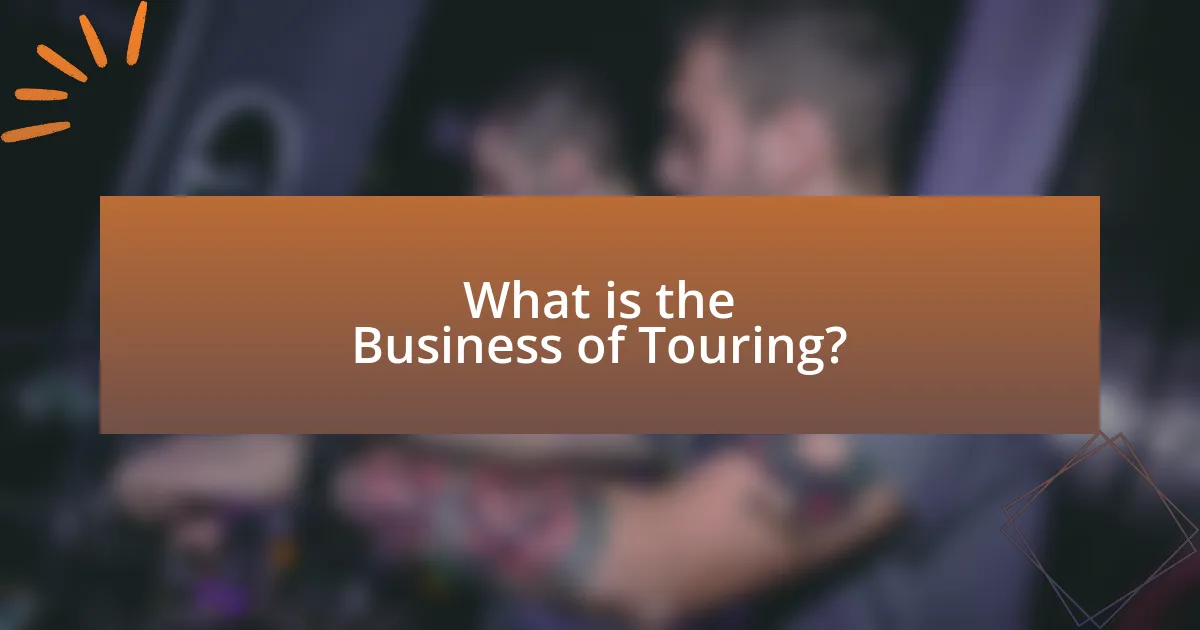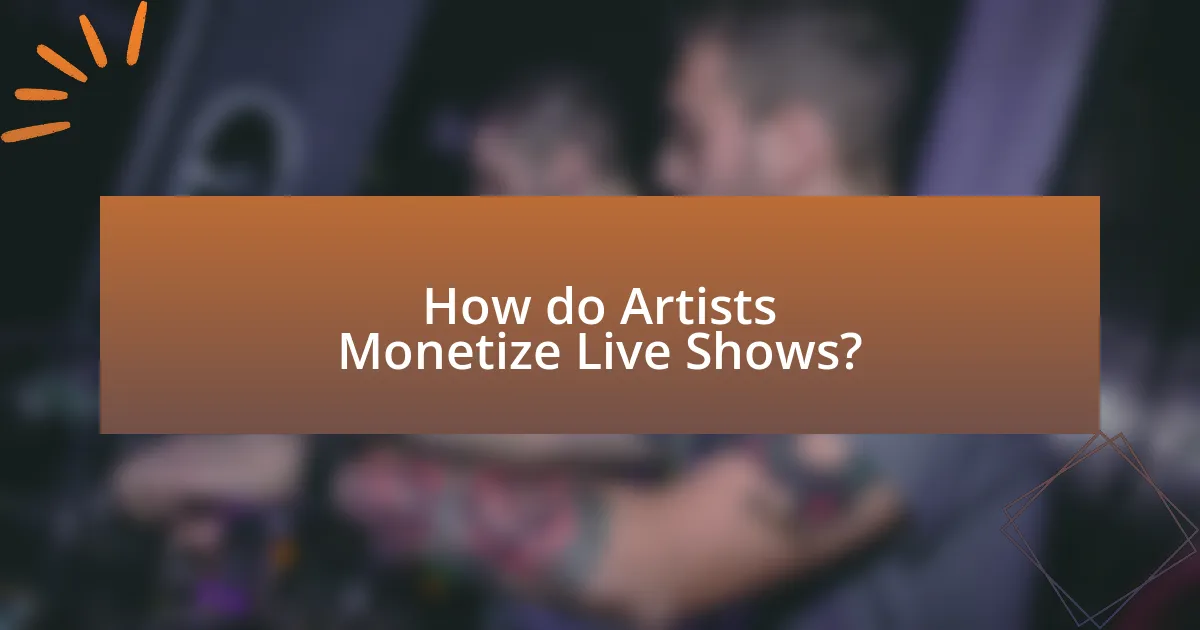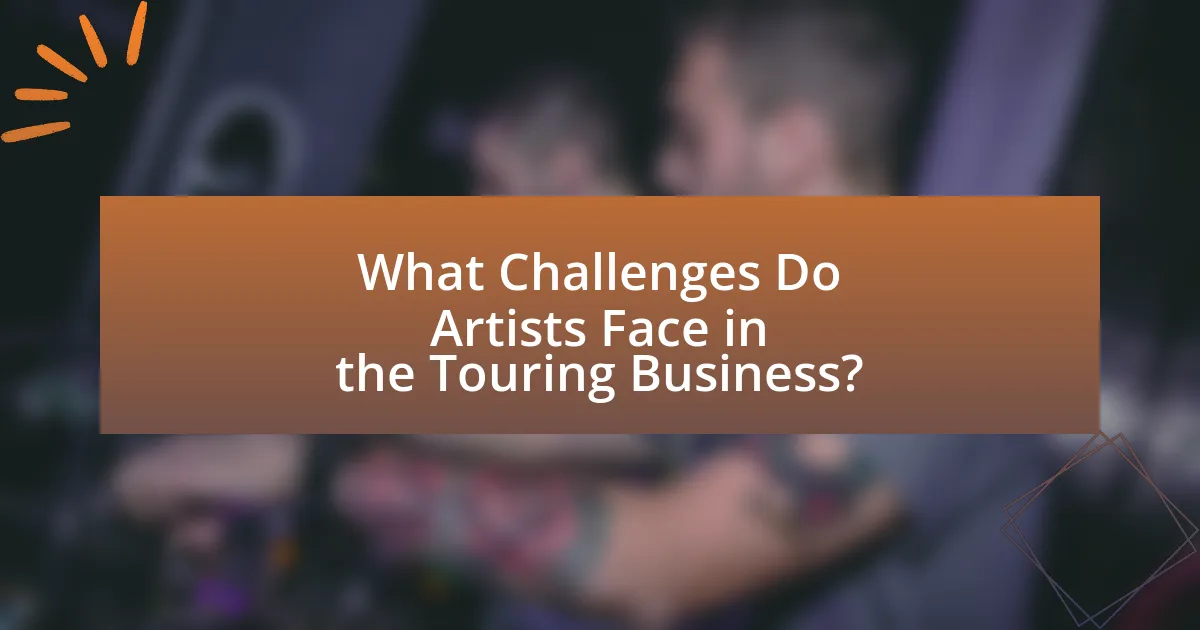The business of touring encompasses the commercial activities associated with live performances by artists, generating revenue through ticket sales, merchandise, sponsorships, and concessions. This sector is vital for musicians, often yielding more income than recorded music sales, with the global concert industry valued at approximately $28 billion in 2019. Artists develop touring strategies based on market demand, audience demographics, and logistical considerations, while various genres influence their touring approaches. The article explores the importance of touring for artists, the primary revenue sources, the challenges faced, and best practices for successful touring, providing a comprehensive overview of how artists monetize live shows.

What is the Business of Touring?
The business of touring refers to the commercial activities surrounding live performances by artists, where they generate revenue through ticket sales, merchandise, sponsorships, and concessions. This sector is a significant revenue stream for musicians and performers, often surpassing income from recorded music sales. For instance, in 2019, the global concert industry was valued at approximately $28 billion, highlighting the financial impact of live events. Additionally, artists often collaborate with promoters and venues to maximize their reach and profitability, further solidifying the business of touring as a crucial component of the entertainment industry.
How do artists define their touring strategies?
Artists define their touring strategies by analyzing market demand, audience demographics, and logistical considerations. They assess factors such as venue capacity, ticket pricing, and regional popularity to optimize their reach and profitability. For instance, a study by the Music Industry Research Association found that artists who tailor their tours based on local fan engagement and historical sales data significantly increase their ticket sales and overall revenue. Additionally, artists often collaborate with promoters and booking agents to refine their strategies, ensuring that their tours align with current trends and maximize exposure.
What factors influence an artist’s decision to tour?
An artist’s decision to tour is influenced by several key factors, including financial considerations, audience demand, and promotional opportunities. Financially, artists assess potential revenue from ticket sales, merchandise, and sponsorships, which can significantly impact their earnings. Audience demand is gauged through streaming data, social media engagement, and previous concert attendance, indicating where fans are eager to see live performances. Additionally, touring serves as a promotional tool for new albums or singles, enhancing visibility and driving sales. These factors collectively guide artists in determining the viability and timing of their tours.
How do different genres impact touring approaches?
Different genres significantly impact touring approaches by influencing the size of venues, marketing strategies, and audience engagement methods. For instance, pop artists often perform in large arenas and stadiums, necessitating extensive promotional campaigns and high production values to attract large crowds. In contrast, indie or folk musicians typically favor smaller, intimate venues, which allows for a more personal connection with the audience and often requires less elaborate marketing efforts. Additionally, genres like hip-hop may incorporate unique elements such as collaborations with local artists or community events to enhance engagement and build a loyal fan base. These genre-specific touring strategies are supported by industry data indicating that pop concerts generate higher ticket sales and revenue compared to niche genres, which often rely on merchandise and smaller ticket prices to monetize live shows effectively.
Why is touring important for artists?
Touring is important for artists because it serves as a primary revenue stream and enhances their visibility. Live performances generate significant income through ticket sales, merchandise, and sponsorships, often surpassing earnings from recorded music. For instance, in 2019, the global concert industry was valued at approximately $28 billion, highlighting the financial impact of live shows. Additionally, touring allows artists to connect with fans directly, fostering loyalty and expanding their audience base, which is crucial for long-term success in the music industry.
What revenue streams are generated from live performances?
Live performances generate multiple revenue streams, including ticket sales, merchandise sales, sponsorships, and concessions. Ticket sales typically represent the primary source of income, with artists often earning a significant portion of the revenue from each ticket sold. Merchandise sales, such as clothing and albums, provide additional income, with artists frequently selling these items at venues. Sponsorships from brands looking to reach concertgoers can also contribute substantially to revenue, as companies pay for advertising and promotional opportunities during events. Lastly, concessions, including food and beverages sold at venues, can yield profits for both the venue and the performing artists, especially when artists negotiate a share of these sales.
How does touring enhance an artist’s brand and visibility?
Touring enhances an artist’s brand and visibility by providing direct engagement with fans and creating memorable experiences. Live performances allow artists to showcase their talent in real-time, fostering a deeper emotional connection with the audience. This connection often translates into increased loyalty and word-of-mouth promotion, which are critical for brand growth.
Additionally, touring generates media coverage and social media buzz, amplifying the artist’s presence beyond their existing fan base. For instance, a study by the International Music Summit found that artists who tour extensively see a 30% increase in streaming numbers and social media followers post-tour. This data underscores the effectiveness of live shows in elevating an artist’s profile and expanding their reach in the competitive music industry.

How do Artists Monetize Live Shows?
Artists monetize live shows primarily through ticket sales, merchandise sales, and sponsorship deals. Ticket sales generate the most direct revenue, with artists often setting prices based on venue capacity and demand; for example, major artists can charge hundreds of dollars per ticket, leading to millions in revenue per concert. Merchandise sales, including clothing, albums, and exclusive items, provide additional income, with some artists earning significant profits from on-site sales during performances. Sponsorship deals with brands can also enhance revenue, as companies pay for advertising opportunities and product placements during shows, further increasing the financial viability of live performances. According to a 2020 report by Pollstar, the global concert industry generated over $30 billion in ticket sales, underscoring the financial importance of live shows for artists.
What are the primary revenue sources for touring artists?
The primary revenue sources for touring artists include ticket sales, merchandise sales, sponsorships, and performance fees. Ticket sales typically account for the largest portion of an artist’s income during a tour, with successful shows generating significant revenue based on venue capacity and ticket pricing. Merchandise sales, which can include clothing, accessories, and music, provide an additional revenue stream, often yielding higher profit margins than ticket sales. Sponsorships from brands seeking to reach the artist’s audience can also contribute substantially to an artist’s earnings, as companies often pay for promotional opportunities during concerts. Lastly, performance fees, which are negotiated contracts for the artist’s appearance, can vary widely based on the artist’s popularity and the event’s scale. Collectively, these sources form the financial backbone of an artist’s touring business.
How do ticket sales contribute to overall earnings?
Ticket sales are a primary source of revenue for artists during live shows, significantly contributing to their overall earnings. In the live entertainment industry, ticket sales can account for up to 70% of an artist’s total income from a tour, depending on the scale and popularity of the event. For instance, major artists like Taylor Swift and Ed Sheeran have reported earnings exceeding $300 million from ticket sales alone during their tours, illustrating the substantial financial impact of this revenue stream. Additionally, ticket sales not only generate direct income but also enhance merchandise sales and sponsorship opportunities, further amplifying overall earnings.
What role do merchandise sales play in monetization?
Merchandise sales play a crucial role in monetization for artists during live shows by providing an additional revenue stream beyond ticket sales. This revenue can significantly enhance overall earnings; for instance, artists can earn up to 30% of their total income from merchandise sales at concerts. Furthermore, merchandise serves as a marketing tool, fostering brand loyalty and increasing fan engagement, which can lead to future ticket sales and streaming revenue. The combination of immediate financial gain and long-term brand building underscores the importance of merchandise in an artist’s overall monetization strategy.
How do sponsorships and partnerships affect touring revenue?
Sponsorships and partnerships significantly enhance touring revenue by providing additional financial support and marketing resources. These collaborations allow artists to offset production costs, increase promotional reach, and attract larger audiences. For instance, a study by the Music Industry Research Association found that artists who secured sponsorships experienced a 30% increase in overall tour revenue compared to those without such partnerships. This financial backing not only helps cover expenses but also enables artists to invest in higher-quality production, ultimately leading to a more engaging experience for fans and increased ticket sales.
What types of brands typically sponsor tours?
Brands that typically sponsor tours include beverage companies, technology firms, fashion brands, and automotive manufacturers. Beverage companies, such as Coca-Cola and Red Bull, often seek visibility at live events to promote their products to large audiences. Technology firms like Apple and Samsung frequently sponsor music tours to showcase their latest devices and connect with younger demographics. Fashion brands, including Nike and Adidas, leverage tour sponsorships to align their products with popular artists and cultural movements. Automotive manufacturers, such as Ford and Toyota, use tour sponsorships to enhance brand awareness and engage with potential customers in a dynamic environment. These sponsorships are strategic, as they provide brands with direct access to target audiences and enhance the overall concert experience.
How can artists leverage partnerships for financial gain?
Artists can leverage partnerships for financial gain by collaborating with brands, sponsors, and other artists to create mutually beneficial opportunities. These partnerships can include co-branded merchandise, sponsorship deals for tours, and joint promotional campaigns that increase visibility and revenue. For instance, a study by the Music Industry Research Association found that artists who engage in brand partnerships can increase their income by up to 30% through shared marketing efforts and expanded audience reach. Additionally, partnerships can provide access to resources such as funding for production costs, which can enhance the overall quality of live shows and attract larger audiences, further driving financial success.

What Challenges Do Artists Face in the Touring Business?
Artists face numerous challenges in the touring business, including financial constraints, logistical issues, and health risks. Financially, artists often struggle with high upfront costs for travel, accommodation, and production, which can lead to losses if ticket sales do not meet expectations. Logistically, coordinating schedules, securing venues, and managing transportation can be complex and time-consuming, often requiring significant planning and resources. Additionally, health risks, such as fatigue and exposure to illness while on the road, can impact an artist’s performance and overall well-being. According to a survey by the Music Industry Research Association, 70% of artists reported that financial instability is their biggest concern when touring, highlighting the pervasive nature of these challenges.
What are the financial risks associated with touring?
The financial risks associated with touring include high upfront costs, unpredictable revenue, and potential losses from low ticket sales. Artists and their management must invest in expenses such as travel, accommodation, production, and marketing before any income is generated. For instance, a 2019 report by the Music Industry Research Association indicated that 60% of tours do not break even due to factors like venue capacity and market demand fluctuations. Additionally, unforeseen circumstances such as cancellations or delays can lead to significant financial losses, further complicating the financial landscape of touring.
How do production costs impact profitability?
Production costs directly impact profitability by determining the net income an artist earns from live shows. Higher production costs, such as expenses for staging, sound equipment, and personnel, reduce the overall profit margin. For instance, if an artist generates $500,000 in ticket sales but incurs $300,000 in production costs, the profit is only $200,000. Conversely, lower production costs can enhance profitability, allowing artists to retain a larger share of their revenue. According to a report by Pollstar, the average production cost for a major tour can range from 30% to 50% of gross revenue, illustrating the significant effect of these costs on an artist’s financial outcome.
What unexpected expenses should artists prepare for?
Artists should prepare for unexpected expenses such as equipment repairs, travel delays, and venue-related costs. Equipment repairs can arise from wear and tear or accidents during transport, potentially costing hundreds to thousands of dollars. Travel delays, including missed flights or vehicle breakdowns, can lead to additional accommodation and transportation expenses. Venue-related costs may include unexpected fees for utilities, cleaning, or security, which can significantly impact the overall budget. According to a survey by the Music Industry Research Association, 70% of touring artists reported encountering unforeseen costs that affected their profit margins.
How do logistical challenges affect touring success?
Logistical challenges significantly hinder touring success by disrupting schedules, increasing costs, and affecting audience engagement. For instance, delays in transportation can lead to missed performances, which directly impacts ticket sales and artist reputation. Additionally, complications in securing venues or managing equipment logistics can inflate operational expenses, reducing overall profitability. A study by the International Live Music Conference found that 30% of touring artists reported financial losses due to logistical issues, underscoring the critical role that effective logistics play in the success of live shows.
What are the common logistical issues artists encounter on tour?
Artists commonly encounter logistical issues such as transportation challenges, scheduling conflicts, and equipment management while on tour. Transportation issues can arise from delays in travel, vehicle breakdowns, or inadequate transportation arrangements, impacting the timely arrival at venues. Scheduling conflicts often occur due to overlapping commitments, leading to difficulties in coordinating rehearsals, sound checks, and performances. Equipment management issues include the risk of damage or loss of instruments and gear, which can disrupt performances and require costly replacements or repairs. These logistical challenges can significantly affect an artist’s ability to deliver consistent and high-quality live shows, ultimately impacting their revenue and reputation in the touring business.
How can effective planning mitigate these challenges?
Effective planning can mitigate challenges in the business of touring by ensuring that logistical, financial, and promotional aspects are thoroughly organized. By creating detailed itineraries, artists can avoid scheduling conflicts and optimize travel routes, which reduces costs and enhances audience engagement. Financially, budgeting and forecasting allow artists to allocate resources efficiently, minimizing the risk of overspending and maximizing profit margins. Additionally, strategic marketing plans can increase ticket sales and audience reach, addressing potential attendance issues. Research indicates that well-planned tours can increase revenue by up to 30%, demonstrating the tangible benefits of effective planning in overcoming common touring challenges.
What best practices can artists adopt for successful touring?
Artists can adopt several best practices for successful touring, including thorough planning, effective marketing, and audience engagement strategies. Thorough planning involves creating a detailed itinerary that includes logistics such as travel, accommodation, and venue arrangements, which helps to minimize unexpected challenges. Effective marketing strategies, such as leveraging social media platforms and email newsletters, can significantly increase ticket sales and audience awareness. Additionally, engaging with the audience through meet-and-greet sessions or interactive performances fosters a loyal fan base and enhances the overall concert experience. According to a report by Pollstar, artists who actively engage with their audience online see a 30% increase in ticket sales compared to those who do not.
How can artists effectively market their tours?
Artists can effectively market their tours by leveraging social media platforms, engaging with fans through targeted advertising, and utilizing email marketing campaigns. Social media allows artists to reach a broad audience, with platforms like Instagram and Facebook enabling direct interaction and promotion of tour dates. Targeted advertising on these platforms can increase visibility among specific demographics, enhancing ticket sales. Additionally, email marketing campaigns can keep fans informed about tour announcements, exclusive pre-sale opportunities, and special promotions, fostering a sense of community and urgency. According to a 2022 survey by Eventbrite, 70% of concertgoers reported discovering events through social media, highlighting its effectiveness in tour marketing.
What strategies can enhance audience engagement during live shows?
To enhance audience engagement during live shows, artists can implement interactive elements such as live polls, Q&A sessions, and social media integration. These strategies encourage real-time participation, making the audience feel more involved and connected to the performance. For instance, a study by the University of Southern California found that shows incorporating audience interaction saw a 30% increase in audience satisfaction ratings. Additionally, utilizing technology like augmented reality can create immersive experiences that captivate attendees, further boosting engagement levels.
